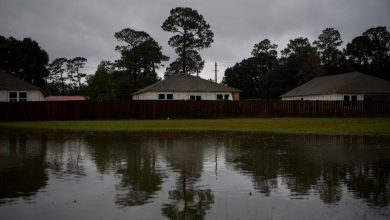How the Picture of Top Secret Folders at Mar-a-Lago Came About

The Justice Department used 35 pages of type in a court filing on Tuesday to provide new details of its investigation into former President Donald J. Trump’s handling of hundreds of classified documents that were taken from the White House at the end of his term.
But the most easily digestible element of the filing was appended at the end: a single photograph showing documents with secret and top secret markings arrayed on a patterned carpet, with a carton of framed pictures on one side. The photograph did not clearly display any details of the subject matter of the documents, which were conspicuously bordered in red when labeled secret and in yellow for top secret.
On Wednesday, Mr. Trump took to his social media site to say that “the F.B.I., during the raid of Mar-a-Lago, threw documents haphazardly all over the floor (perhaps pretending that it was me that did it!), and then started taking pictures of them for the public to see.”
But the genesis of the photograph appears to be in keeping with standard protocols for how federal agents handle evidence they come across in a search.
The folders were arrayed by agents at Mar-a-Lago after being removed from what the filing indicated was Mr. Trump’s office — they were not discovered scattered on the floor, according to two federal law enforcement officials.
The Justice Department would not comment on the specifics of the photograph. But it is standard practice for the F.B.I. to take evidentiary pictures of materials recovered in a search to ensure that items are properly cataloged and accounted for.
The marking “2A” on a folded piece of paper in the picture corresponds to a listing in the inventory of items seized in the search that was made public along with the search warrant. In that inventory, the item marked as “2A” is described as “various classified TS/SCI documents.”
Files or documents are not tossed around randomly, even though they might appear that way; they are usually splayed out so they can be separately identified by their markings. The ruler seen in the image is to give a sense of their size in relation to other objects.
One noteworthy element of the photograph, as the Justice Department pointed out in its filing yesterday, is that none of the folders bear a label or stamp indicating that Mr. Trump declassified them, as he has periodically claimed when asked about his retention of government materials requested by the National Archives. Documents that have been declassified typically contain explicit markings indicating the change.




